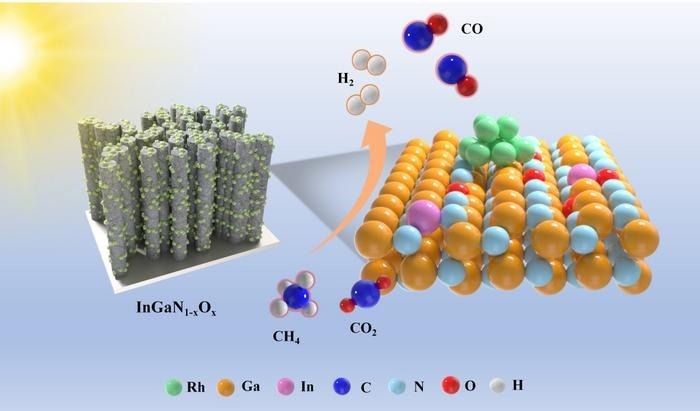Reviewed by Lexie CornerMay 8 2024
Researchers from Shanghai Jiao Tong developed a new photocatalyst that uses concentrated sunlight to convert methane waste gas and CO2 into syngas, a valuable fuel precursor. This approach is much more energy-efficient and less prone to deactivation than existing methods. This study’s results were published in the esteemed journal Science Bulletin.
 Rh/InGaN1-xOx nanowires were explored for light-driven methane dry reforming with carbon dioxide towards syngas (CH4 + CO2 + light = 2CO + 2H2). It is proposed that the partial substitution of N in InGaN with O can greatly improve the activity and stability of the catalyst under light illumination without extra heating. Image Credit: Science China Press
Rh/InGaN1-xOx nanowires were explored for light-driven methane dry reforming with carbon dioxide towards syngas (CH4 + CO2 + light = 2CO + 2H2). It is proposed that the partial substitution of N in InGaN with O can greatly improve the activity and stability of the catalyst under light illumination without extra heating. Image Credit: Science China Press
The Rh/InGaN1-xOx material performs exceptionally well for the dry reforming of methane (DRM) with CO2 under concentrated solar illumination, achieving a syngas evolution rate of 180.9 mmol gcat-1 h-1 with 96.3% selectivity. This is a major improvement over traditional catalytic systems, which frequently suffer from rapid deactivation and high energy input requirements.
Our work represents a major step forward in addressing the dual challenges of greenhouse gas emissions and sustainable energy production. By leveraging the power of solar energy and rationally designed nanoarchitecture, we have demonstrated a green and efficient route for converting waste gases into valuable chemical resources.
Baowen Zhou, Professor and Lead Researcher, Shanghai Jiao Tong University
The researchers ascribed the remarkable activity of their photocatalyst to the combined action of the oxygen-modified surface, photo-active InGaN nanowires, and catalytically active rhodium nanoparticles. Mechanistic investigations have demonstrated that the oxygen atoms that have been incorporated are essential for stimulating CO2 activation, enabling the generation of CO, and preventing catalyst deactivation through the process of coking deposition.
The results of this study lay the groundwork for advancing photocatalytic systems aimed at sustainably producing fuels and chemicals from renewable resources. The group thinks that by applying their methodology to additional significant chemical reactions, new avenues for environmentally friendly chemical industry practices will become available.
We are excited about the prospects of this technology. By further optimizing the catalyst design and reactor configuration, we aim to scale up the process and demonstrate its viability for practical applications.
Baowen Zhou, Professor, School of Mechanical Engineering, Shanghai Jiao Tong University
Journal Reference:
Li, Y., et al. (2024) Rh/InGaN1−xOx nanoarchitecture for light-driven methane reforming with carbon dioxide toward syngas. Science Bulletin. doi.org/10.1016/j.scib.2024.02.020.